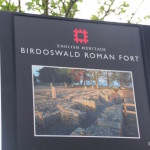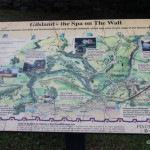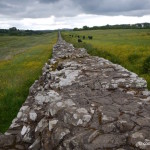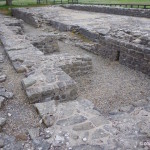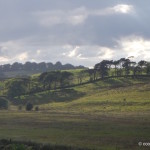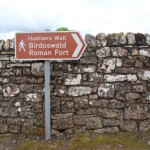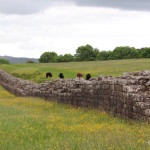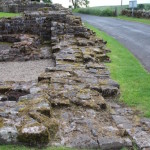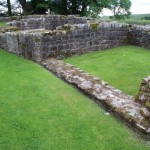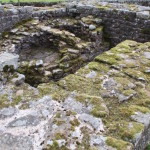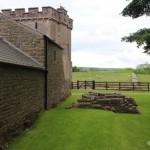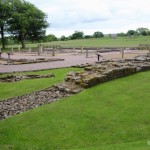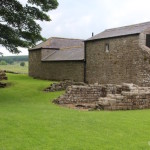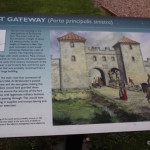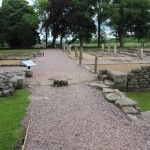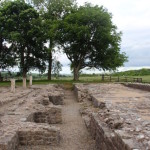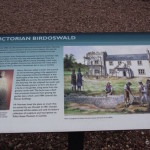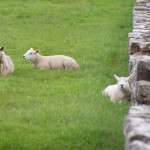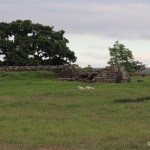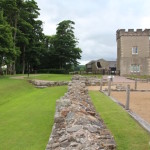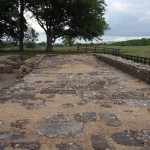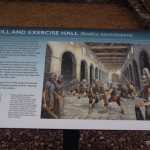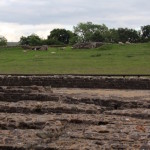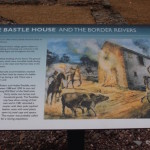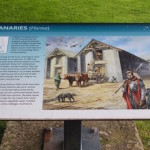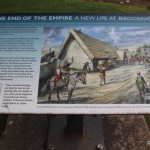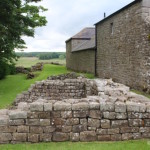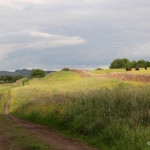Hadrian’s Wall at Birdoswald Fort
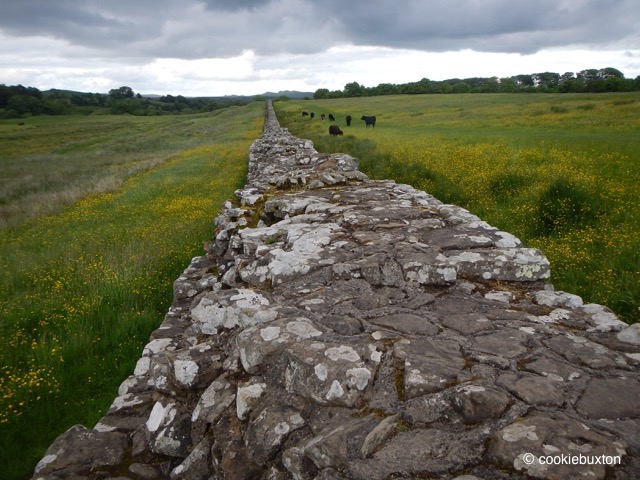
Visiting Hadrian’s Wall, at the site of Birdoswald Fort, one of the Roman military sites along Hadrian’s Wall in England, was fascinating for me. I had long wanted to see the remnants of the ancient wall that runs between the Irish Sea and the North Sea. Travelling to view a segment of the wall at Birdoswald (also referred to as Banna), which has been occupied by one type of settlement or another since its construction, was a wonderful choice of location for us. I felt I had been transported to another “time and place” in history, and felt deeply satisfied to have seen this world heritage site.
I do want to tell you about getting there, before talking a bit more about the Birdoswald fort. Being Canadian, in our country we drive on the right side of the road, and the driver sits on the left side of the car. In Scotland, England, and Wales, the driver sits on the right side of the car, and the car travels on the left side of the road. This visit to Hadrian’s Wall took place on day three of our trip to Great Britain, and I was the designated, novice left-side driver on this trip. (My husband braved the Autobahn in Germany on a different trip, so we decided this was a fair deal.) So, being the driver, I am well able to describe the wild trip from Gretna Green in Scotland to Birdoswald at dusk on a summer evening, driving along an innovative route that was pretty much “as the crow flies”, thanks to our inability to weed out backcountry lanes from our handy in-car GPS.
Hubby Art and I were approaching Hadrian’s Wall from the west, having driven south from Dawyck Garden and stopping to visit Greta Green that same day. We travelled east of Gretna Green for probably 45 minutes to an hour along the skinniest country lanes I have ever seen, with stone walls and shrubs removing whatever breathing room the road might otherwise have provided. The favourite part of the drive was “meeting up with a Lorrie,” and while I didn’t personally speak to the driver, he must have known how indebted I would feel for him being the one to back up to the nearest farm gate, where the road widened ever so slightly, to let me squeeze by.
Now and then, we would come over a rise, and be able to see out over the stone walls and shrubs on either side of the road to catch a glimpse of the lovely countryside in this region. The rest of the driving left us “blind”, as we could see neither left nor right above the shrubs and stone fences hugging the road, nor see much in front of us along the winding, skinny lanes.
Hadrian’s Wall at Birdsowald Fort
Once we arrived at Birdoswald, my fatigue from the day’s travels fell away. I felt almost immediately like we had gone back in time. We arrived after the visitor centre was closed, the parking lot was empty, and we were the only ones at the site. It was a quiet, peaceful place, and we took our time viewing the wall, looking at the remains of the fort, and examining the old settlement buildings. We marvelled at what remained of the wall, stretching out as far as we could see.
Construction of Hadrian’s Wall was begun in AD122 and continued for a period of close to six years. The wall was 117 or so kilometres, or 73 miles, in length (decribed in some sources as 80 Roman miles long). It was wider in some parts, higher in other areas, and there was a stretch through one region where the wall was made of turf, and later rebuilt in stone. For much of its territory, the wall was roughly three metres (about 10 feet) wide, and about six metres (20 feet) high. There are, in some regions, sections of the wall still intact to a height of three metres (10 feet). In recent years, a number of movies have included images and references to Hadrian’s Wall, such as the 2004 production of King Arthur, and movies such as Centurian, The Eagle, and 2015’s Dragonheart 3. Hadrian’s Wall is also a thematic element in many novels and poems, and was, for example, acknowledged by author George Martin to be the inspiration for the great northern wall in his Game of Thrones novels.
On the south side of the wall, the Roman soliders constructed a deep ditch, termed the Vallum, running parallel to the wall. The wall itself was built by the Roman legions, said to have numbered in the 9,000 range, and they were the ones who patrolled the milecastles or milefortlets, and looked out from the turrets, and manned the garrisons and forts, controlling trade and commerce and travel in the north of England awhile repelling attacks from time to time by the Picts and other folks.
At Birdoswald, as you can see in the photographs, much of Hadrian’s Wall has been dismantled, with stones being removed over the centuries since the withdrawal of the Roman military from the countryside around AD410. The stones have been “repurposed” back into the landscape, used for building other stone farm fences and military and civilian roadways, long after the wall was abandoned by the Romans.
Over time, Hadrian’s Wall has regained a scale that once again fits into the landscape, resembling as it does now countless other stone farm fences that criss-cross the valleys and fields of Great Britain.
There is something comforting in seeing this old wall, separated by 20 centuries from wars between Picts and Romans, in the soft light of dusk, fitting in once again into the landscape, and serving today as a memory marker of its earlier, significant role in the political landscape of its day.
Looking out at Hadrian’s Wall on that lovely June evening, I felt in awe of the effort that would have been expended in building such a structure. Fortunately, with its designation as a UNESCO heritage site in 1987 (UNESCO stands for United Nations Educational, Scientific, and Cultural Organization) and inclusion as part of UNESCO’s transnational “Frontiers of the Roman Empire” in 2005, along with the local and national commitment to maintain forts such as Birdoswald as museums and centres for active historical research, portions of Hadrian’s Wall will undoubtedly remain intact for generations to come.
It is interesting to think about the physical walls that have gone up and come down over the centuries: the incredible, and largely intact 6259-kilometre (3889-mile) Great Wall in China – which in full measures 8,850 kilometres when you include natural segments of mountain and river fordings incorporated into the route; Hadrian’s Wall, and its shorter, sister wall to the north, the Antonine; the Berlin Wall; and walls of lesser and greater magnitude in countless other locations.
I hope people do not continue, in this modern day, to build walls across the breadth of an entire nation – as is proposed by the United States along its southern border. Walls divide us, restrict and corral people, typically represent some form of oppression, and, beyond affecting people, also restrict wildlife. It is good to see these physical walls come down, stone by stone. The type of walls we continue to build in the modern age tend to be invisible to the eye, and we need discernment and commitment to bring these down as well.
I am, though, very glad to see this wall still intact, to help us remember, and mentally reconstruct, and understand, this remarkable artefact from an important era in the history of the western world.
The visit to Hadrian’s Wall was a memorable trip for me, and the images from Birdoswald Fort with Hadrian’s Wall stretching across the countryside will linger in my memory.
If you are visiting Hadrian’s wall, and want to take time to walk alongside it for a way, you can do so along a national path that follows the wall from Wallsend to Bowness-on-Solway.
Related stories are listed in My Post-British-Garden-Tour Blues.
Photos and text: Nadine Kampen / cookiebuxton
Photo location: Hadrian’s Wall, Birdoswald Fort, England (June 2016)
PHOTO GALLERY
Click on any photo to enlarge; click again on the photo to advance.
